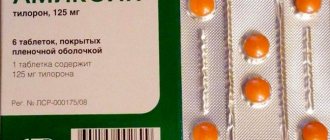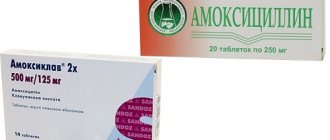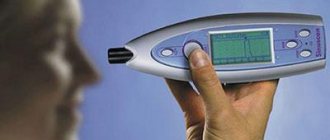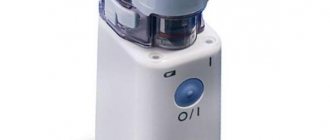Inhaler
Steam. This is the most common type of device; it allows you to inhale the vapor of a medicinal product, for example, various herbal infusions or sea water. Among the advantages of this device, one can note their accessibility and ease of use, but it cannot affect the lower respiratory tract.
Compression. This type of inhaler delivers aerosol substances to the desired part of the respiratory tract through a compressor, hence the disadvantage of this device is quite significant noise. But it has the broadest potential for treating diseases.
Ultrasonic. This type of device differs from others in that it turns medications into an aerosol using ultrasound . Unlike compression, it has small dimensions and is absolutely silent, but at the same time it is limited in the use of funds.
MESH inhaler. It forms an aerosol from a substance using vibrations of a membrane film with nanoholes. This is the most compact inhaler on our list. It allows you to use a fairly wide range of drugs without changing their concentration, and provides the best absorption of drugs. But I would like to note that due to the high price, it is not available to everyone. So, we have looked at all the types of devices that interest us, and now let’s move on to the nebulizer and see if there is a difference between them.
Nebulizer or inhaler - what's the difference?
Respiratory diseases are among the most common in the world. One of the most effective ways to treat them is inhalation or nebulizer therapy. What it is? What are their similarities and differences? We will talk about this in this article.
Inhalers and nebulizers are designed to treat respiratory diseases. The principle of their operation is approximately the same, but still there are some differences.
Inhalers and nebulizers – what are they?
So, a little terminology.
An inhaler (from Latin inhalo - I inhale) is a device designed for administering medications by inhalation. Medicines are converted into vapor or aerosol. In addition, powdered products can also be inhaled. A nebulizer is a type of inhaler that generates an aerosol with a certain particle size from liquid medications.
Types of nebulizers
Now that we have understood the terminology, let's look at the types of nebulizers. The devices differ in their operating mechanism. Nebulizers are:
- compressor;
- ultrasonic;
- mesh.
Compressor nebulizers convert medication into an aerosol using a compressor. As a rule, such devices are used for home treatment. They are easy to use and store, and work with a wide range of medications. With a lot of advantages, such nebulizers have one disadvantage - the loud operation of the compressor. But it is worth noting that even the loud operation of a compressor can only frighten a very small child. In addition, there are quiet nebulizers designed specifically for children.
Ultrasonic nebulizers break down medication into an aerosol using ultrasound. The main advantages of such devices include silent operation and the ability to generate a fine aerosol that penetrates deep into the lower respiratory tract. The disadvantages of these devices, perhaps, include a rather narrow range of medications with which this type of device can work.
Mesh nebulizers convert drugs into an aerosol using a vibrating mesh membrane. Such devices are silent and convenient. Some models, such as OMRON U22, allow inhalation from any angle, even while lying down.
What are nebulizers used for?
The purpose of nebulizers, like any inhalers, is to treat various respiratory diseases. The ability to convert drugs into an aerosol allows the drug to be delivered directly to the site of inflammation. It is absolutely impossible to treat, for example, bronchitis or asthma using a conventional steam inhaler. Large droplets of steam are simply unable to “reach” the inflamed organs and settle in the upper respiratory tract.
The use of inhalers is justified for mild colds of the upper respiratory tract and for aromatherapy. To treat serious colds or infections or allergies, the medicine must be sprayed into small particles.
To summarize, we can conclude that nebulizers are a type of inhalers designed to treat a wide range of diseases.
Nebulizer
A nebulizer is a device that is capable of converting substances from a liquid state into an aerosol and introducing them into the body through inhalation . Depending on the operating principle, such a device can be ultrasonic, compressor or electronic mesh (MESH). These devices are used mainly to treat diseases of the lower respiratory system. And in the end, we get that a nebulizer is, in fact, a type of inhaler. But we will not dwell on this and will still consider the difference using the example of a steam inhaler and any nebulizer.
Steam inhaler.
- Used for steam inhalation
- The liquid is heated to produce steam
- Delivers drugs to the upper respiratory system
- For procedures, you can use both herbal decoctions and oils
- Used to treat colds and acute respiratory viral infections
- Not recommended for use on small children
- Do not use antibiotics, mucolytics, hormonal or similar drugs
Nebulizer.
- Drip administration is used
- Converts liquid into an aerosol with small particles
- Directs medicine to any part of the respiratory system
- Do not use oils or herbal infusions
- Used to treat severe respiratory diseases
- Suitable for use on infants
- Possibility to use drugs from the group of bronchodilators, antibiotics, mucolytics, hormones
Mechanism of action of devices
Until recently, only a regular inhaler could be purchased in pharmacies, but now a worthy competitor has appeared - a nebulizer. Buyers ask how an inhaler differs from a nebulizer, which will have the maximum effect in the fight against respiratory diseases. To find out, you need to understand the features of their functioning.
An inhaler (translated from Latin Inhalo - means “I inhale”) is a device that, using inhalation, delivers a medicinal substance in a vapor state into the human body.
It quickly reaches the affected area and produces a therapeutic effect on the area of the mucous membrane affected by viruses. The main task of the device is the prevention and treatment of acute respiratory viral infections, bronchitis, pharyngitis, sinusitis, asthma, etc. The inhaler converts the drug into a dispersive composition with particles ranging in size from 0.5 to 10 microns. The smaller the particle, the better it will be absorbed by the mucous membrane. Inhalers are divided into three types:
Steam. Easiest to use. Inhalations can be carried out with a decoction of herbs, an isotonic solution, or oil-based medications (Chlorophyllipt). Use only for the treatment of the upper respiratory tract.- Compressor. Delivers the solution directly to the diseased area, almost any disease can be treated. The disadvantage of the inhaler is the loud noise during operation.
- Ultrasonic. Converts the medicinal composition into an aerosol. The advantage of the inhaler is its silent operation and small size.
A nebulizer (translated from Latin Hebula - means “cloud” or “fog”) is a device that converts a set of medications from a liquid state into an aerosol and delivers them by inhalation to the organs. Nebulizers are divided into two types: ultrasonic and compression. The difference between a nebulizer and an inhaler is a more advanced way of breaking the active substance into small particles. Depending on the size of the particles, certain diseases are treated.
So, particles, size:
- from 8 to 10 microns, treat inflammation of the oral cavity (stomatitis, gingivitis),
- from 5 to 8, treat ENT organs (rhinitis, laryngitis, tonsillitis),
- from 3 to 5, treat inflammation of the trachea, chronic and obstructive bronchitis. This drug thins mucus and helps it clear easily,
- from 1 to 3 microns and smaller, treat severe lung diseases. The particles deliver the solution to the alveoli.
The purposes of both the inhaler and the nebulizer are similar - to deliver medicine to the human respiratory system. But the latter is able to provide a more precise effect of the solution on a specific area.
Compression, Ultrasonic or MESH, what to choose?
If we choose between these three devices, then we need to pay attention to the price range and mobility of the devices, but there are many different models, and to decide, let’s take a closer look at the differences between these types.
Let's start with compression. This type is the least expensive of the three, but is not very suitable for treating small children, as it creates a lot of noise and cannot be used on a sleeping child, and also has rather large dimensions , which makes it inconvenient for travel. Still, if noise doesn’t bother you and you don’t need to take it with you often, then this is a good option.
Now let's move on to ultrasound. Its advantage over the compression one is its small size and battery operation, so you can easily take it with you. Of the minuses, I would like to note the need to purchase different consumables. And if you have to carry an inhaler with you everywhere, then this is the one you should consider.
And finally, we move on to MES inhalers. Undoubtedly, this is the most expensive type of device, but it has a number of advantages over others. Firstly, it is very compact, which allows you to always keep it at hand. Secondly, it is very well adapted for use on bedridden patients and is suitable for even the smallest patients. And of course, it is battery powered. So, if the price doesn’t bother you, this device is for you.
So we figured out how a nebulizer differs from an inhaler. Now you can confidently choose the best option for yourself.
Types of inhalers
In total, there are 4 types of inhalation devices:
- steam;
- compression;
- ultrasonic;
- electronic mesh.
The first group of devices are exclusively inhalers, while the last three can be both inhalers and nebulizers. Any type of device is suitable for both adults and children - thanks to the presence of masks and attachments of different sizes in the set.
Children's devices differ only in appearance. They come in the form of a variety of animals or are decorated with pictures to attract the child to the procedure.
Steam
The action of steam inhalers is based on the principle of evaporation of a medicinal substance in the form of steam. This is achieved by heating the inhalation solution to boiling point. The peculiarity is that this indicator should be below 100 degrees. This limitation sharply narrows the range of substances that are used for inhalation by these devices. These include: mineral and salt waters, essential oils and oil-based herbal infusions.
Another disadvantage of using a steam inhaler is the inability to carry out procedures when the patient’s body temperature is above 37.5 degrees, as this can lead to significant overheating of the entire body. Passive evaporation of the drug leads to the formation of large particles that do not reach the lower respiratory tract. This process also causes a low concentration of the drug in the evaporated air. These factors lead to a decrease in the effectiveness of the procedure and the possibility of its use exclusively for mild inflammatory processes of the upper respiratory tract, such as laryngitis, tracheitis, pharyngitis.
The advantages of steam inhalers include low cost and the ability to use oil solutions, which is not acceptable in all nebulizers.
Compression
Compressor (or compression) type inhalers are the most versatile devices. With their help, all medicines are sprayed, regardless of structure. The mechanism of operation of these devices is to break down the medicinal substance using a powerful stream of air passing through a container with a solution. The sizes of the resulting particles are so small that they reach the most distant bronchioles. This type of nebulizer is indispensable for people suffering from chronic lung diseases.
The disadvantages of a compression device are significant noise and large size. This inhaler is only suitable for home use and cannot be taken with you on vacation.
Ultrasonic
Nebulizers that achieve the breakdown of the drug by vibrating the emitter plate are called ultrasonic. The advantages of these devices are that they operate almost silently and take up less space than compressor inhalers. The number and size of solution particles create a huge fine cloud that can spread not only over the mouthpiece, but also significantly beyond the inhaler itself. This makes it possible to go about your business and carry out the treatment procedure in the same room with a working device.
A negative feature of ultrasonic nebulizers is the fact that the effect of this type of radiation has a destructive effect on a number of medications. With this type of inhaler, bronchodilators and bronchodilators prescribed to patients with chronic lung diseases can be used, but antibiotics cannot be used.
Electronic mesh
Nebulizers in this category are the most modern. They eliminate the main disadvantages of previous types of inhalers. With their help, it is possible to spray all medications in any conditions. This is achieved using mesh technology, which consists of forcing the solution using vibration through invisible holes in the membrane built into the inhaler. The particles coming out of the nebulizer are so small that they reach all parts of the lungs. The size of the electronic mesh inhaler is several times smaller than the size of other devices, so you can always carry it with you in your pocket or take it on a trip.
The disadvantage of the device is its high price.
What is the difference between a nebulizer and an inhaler?
All devices for inhalation can be divided into inhalers and nebulizers.
Inhalers are all devices that provide the process of evaporation of medicinal substances. Such vapors are freely inhaled by patients through the respiratory system, which has a local therapeutic effect. Nebulizers are devices that, using certain mechanisms in their device, actively ensure the splitting of a medicinal substance into microparticles of various diameters required in each specific case.
A nebulizer differs from an inhaler in that an inhaler is any device for performing inhalations, and a nebulizer is only a device with which you can adjust the required particle size of the drug for the procedure. Externally, the devices look identical to each other.
Differences between an inhaler and a nebulizer:
| Sign | Inhaler | Nebulizer |
| Definition | Includes all devices used for inhalation | A group of inhalers capable of generating vapors of varying dispersity |
| Kinds | Steam, compressor, ultrasonic, electron mesh | Compressor, ultrasonic, electronic mesh |










